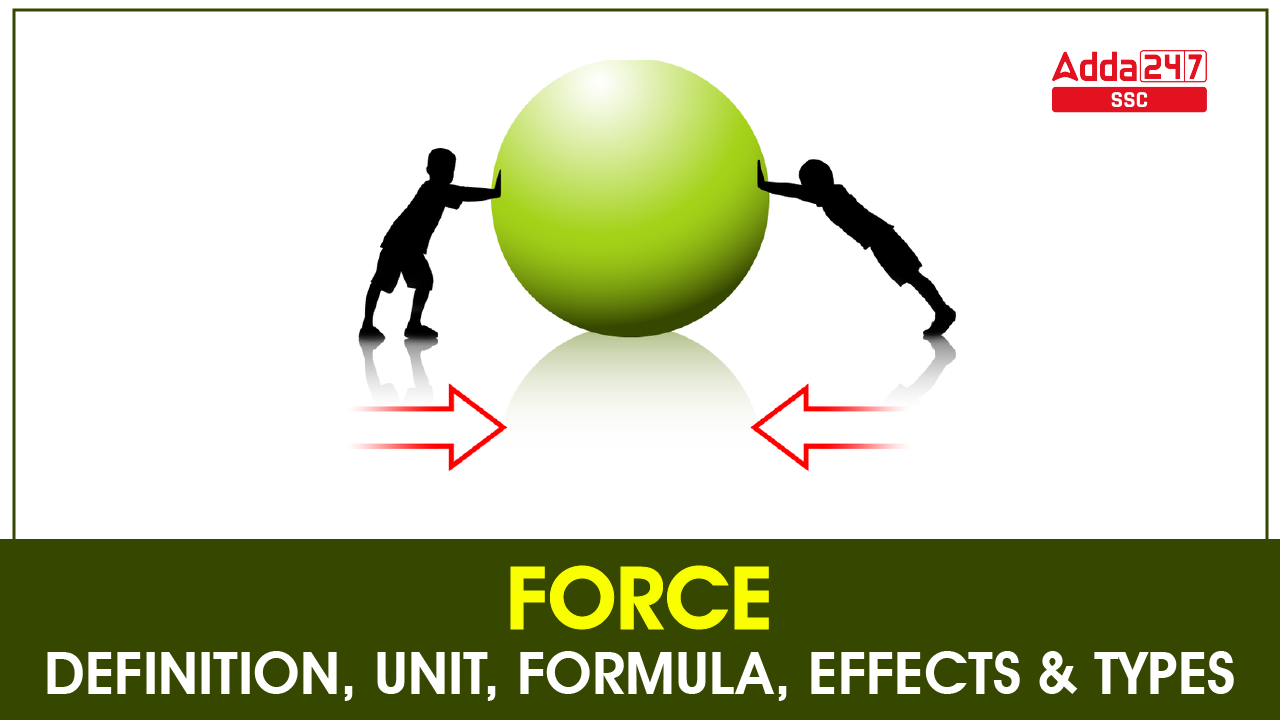Table of Contents
What is Force?
A force is an interaction of the object with mass that causes the object to change its velocity. It can be defined as the push or pull on a particular object. A force is a vector quantity which means it has both magnitude and direction. When objects interact with one another, it is likely to cause a push or pull resulting in the Force. For example, when you try to push a ball, it causes a force on the ball that changes its state of motion. The external force applied has the ability to change the position of a particular object. The direction in which the force is applied is known as the direction of Force. In this post, we will discuss everything related to Force including its Formula and Types. Check out the article below to learn about Force.
Unit of Force
The SI unit of Force is Newton(N). However, Force can also be defined in various other units as given in the table below.
| Common symbols: | F→, F |
| SI unit | Newton |
| In SI base units: | kg·m/s2 |
| Other units | dyne, poundal, pound-force, kip, kilopond |
| Derivations from other quantities | F = m a |
| Dimension | LMT-2 |
Periodic Table: Groups, Properties And Laws
Effects of Force
Whenever a Force is applied to any object, it tends to change its shape, size, speed, or direction. It changes the motion of an object. Motion is the movement of a body. Here are some of the effects that force has on its objects:
- It changes the direction of an object.
- It can make a body at rest move.
- It can change the speed of an object by either increasing or decreasing it.
- It can stop a moving object.
- It can change the shape or size of an object.
Formula of Force
Force can be explained by the product of mass (m) and acceleration (a). The equation for the formula of Force can be expressed in the form given below:
F = ma
Where,
- m = mass
- a = acceleration
It is formulated in Newton (N) or Kgm/s2.
Acceleration “a” is given by, a = v/t
Where,
- v = velocity
- t = time taken
So Force can be defined as F = mv/t
The inertia formula is termed p = mv which can also be explained as Momentum.
Types of Force
There are various types of Force that act on an object. Here are some of Force applied on an object generally:
- Muscular Force
- Mechanical Force
- Frictional Force
- Gravitational Force
- Electrostatic Force
- Magnetic Force
Let’s take a look at the Types of Force in detail:
- Muscular Force
It can be simply defined as the force that we apply on a daily basis by the work we do such as lifting, breathing, exercising, etc. It acts after coming in contact with the object. This force results due to the action of our muscles. When we use our muscles to do the daily chores, muscular force is exerted on the object.
2. Mechanical Force
Mechanical force occurs when there is direct contact between two objects where one object is applying the force while the other one is in a state of rest or in the state of motion. Someone pushing the door is an example of Mechanical force.
3. Frictional Force
Frictional Force is the opposing force created between two surfaces whose main purpose is to create resistance to the object either moving in the same direction or opposite direction. When we put brakes while riding a cycling act as a frictional force.
4. Gravitational Force
Gravitational Force is the force of attraction that attracts two objects with masses. Earth’s gravitational force pulls us to the ground. It always tries to pull the masses towards each other and never tries to push them apart. It can be defined as Newton’s Universal Law of Gravitation.
5. Electrostatic Force
Electrostatic Force is also defined as the Coulomb force or Coulomb interaction. It is the force between two electrically charged objects. According to this force, like charges repel while unlike charges attract each other. Lightning is an example of the Electrostatic Force.
6. Magnetic Force
Magnetic Force is the force that arises between electrically charged particles because of their motion. Magnetic force can be seen between the poles of 2 magnets. It is either attractive or repulsive depending upon the orientation of the object. It can be said to be a consequence of Electrostatic forces.



 SSC CGL 2025: Will the Number of Vacanci...
SSC CGL 2025: Will the Number of Vacanci...
 RRB ALP Preparation Strategy 2025, Tips ...
RRB ALP Preparation Strategy 2025, Tips ...
 SSC CGL 2025: Why It Will Be the Most Co...
SSC CGL 2025: Why It Will Be the Most Co...


